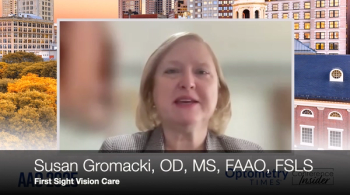
IKA 2024: ABCD versus Amsler-Krumeich classifications
Michael Belin, MD, weighs the ABCD and Amsler-Krumeich classifications and proposes ABCD progression displays as an effective modern alternative.
The Amsler-Krumeich method of disease severity classification has become outdated, according to Michael Belin, MD. In his talk during the International Keratoconus Academy Keratoconus Symposium, Belin offers the ABCD classification, or ABCD progression display, as a more modern alternative to identifying keratoconus.
Video Transcript
Editor’s note - The following transcript has been lightly edited for clarity.
Michael Belin, MD:
I'm Michael Belin, professor of ophthalmology at the University of Arizona. I'm also a consultant to OCULUS and I am chief medical officer of Epion Therapeutics. Yesterday I spoke about a new way to classify disease severity, and also a new way to determine when and if true progression occurs in ectatic disease. So we're all familiar with Amsler-Krumeich. Amsler-Krumeich, while unfortunately still being talked about is a 70 year old, outdated way to classify disease. It's based on a keratometer and an optical perimeter, which really is no longer relevant in clinical ophthalmology or optometry. I introduced what's called the ABCD classification, and from that we developed the ABCD progression display. A stands for anterior radius of curvature; it's taken from the 3-millimeter optical zone centered on the thinnest point; B, or back, is posterior radius of curvature also taken from a 3-millimeter optical zone centered on the thinnest point. As opposed to Amsler-Krumeich, we use the thinnest point not an apical reading because that corresponds to the cone. C is minimal corneal thickness and D is distance visual acuity. The real key, however, was not just coming up with a new classification system, but to be able to determine when and if true progression occurs. And with the ABCD progression display, we can graphically display both anatomical layers, anterior and posterior cornea, corneal thickness, and best spectacle corrected distance visual acuity and determine when and if we have true validated statistically changed. We do this by using 2 different databases, both a normal and a keratoconic. We used the normal database in very young patients and very early disease, and we use the keratoconic database in more established disease. The reason for that is the risk of waiting in a young patient is much higher than in a more old established. There's been a number of at least 8 independent validated published papers on the ABCD progression display. And what what they concluded was it was able to identify true progressive disease on average 6 months earlier in relying on Kmax. So again, the goal in ophthalmology and the goal in optometry should be to identify disease at the earliest possible stage and be able to intervene in this case with cross-linking to preserve vision, not waiting for vision to be lost.
Newsletter
Want more insights like this? Subscribe to Optometry Times and get clinical pearls and practice tips delivered straight to your inbox.















































.png)


